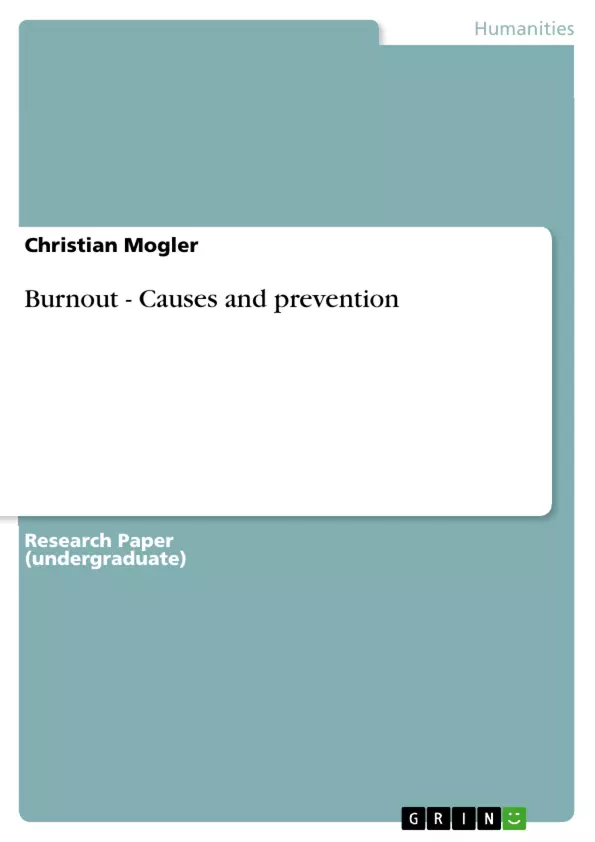Burnout, a term heard with increasing frequency these days, is becoming a prominent fact
of life in the fast-paced and stress-filled 21st century. People in all walks of life are
experiencing burnout, and many end up losing their jobs, their health, and sometimes
their families because of it. Some even commit suicide as a way of escape. Since almost
everybody will experience burnout to a certain degree in some stage of life, one may ask
what exactly burnout is, what the warning signs are, how to deal with it and what can be
done in order to prevent it. The aim of this paper is to answer those questions with a
special emphasis on workaholic and ‘Type A’ personality burnout, since those people are
most prone to the experience it.
[...]
Inhaltsverzeichnis (Table of Contents)
- Introduction
- Definition
- Manifestation
- Mental
- Physical
- Spiritual
- Biblical examples of burnout
- What does Burnout look like practically?
- What Causes Burnout?
- General
- Feeling overwhelmed
- Loss of hope
- The role of stress
- How stress works
- Society
- Job
- Specific professionals
- Caregiver burnout
- MINISTER BURNOUT
- Ministry burnout
- What causes job-burnouts?
- Lack of Recognition
- Big Consequences for Failure
- High-Stress Times with No “Down-times”
- Impossible Requirements
- Unclear Requirements
- Poor Fit for the Job
- Lack of Belief in What You Do
- Shift work
- Bad Leadership
- Lifestyle
- Too Much Work With Little Balance
- No Help or Supportive Resources
- Too Little Social Support
- Too Little Sleep
- Too Little Time Off
- No time for hobbies
- Personality
- Obsessive compulsive personality (OCPD)
- Type-A personality (TAP)
- Type-A personality – its effects
- The workaholic – most likely candidate
- Symptoms of Workaholism
- The reasons for workaholism
- Solution
- Workaholism combined with Type-A personality
- Pessimism
- Idealism/Perfectionism
- Playing God-syndrome
- People Pleaser
- Others
- Unfulfilled expectations
- Bitterness
- Burnout as a virtue
- Other reasons
- Who has a burnout?
- How to get back on track
- Restoring Hope
- After recovering burnout
- Prevention
- Get proper exercise, have a healthy diet and enough sleep
- Carrying God's yoke, not my own
- Forgive
- Carry each other's burden
- Know who you are in Christ - get your thinking right
- Look at the true meaning of life
- Having the right perspective
- Join a small support/prayer group
- Prioritize
- Watch perfectionist tendencies
- Take regular time off
- Relax
- Have fun!
- Change
- Know the warning signs
Zielsetzung und Themenschwerpunkte (Objectives and Key Themes)
This research paper explores the concept of burnout, aiming to understand its definition, manifestations, causes, and potential solutions. It delves into the experience of burnout, particularly in the context of workaholics and individuals with Type-A personalities, presenting strategies for recovery and prevention. The paper examines key themes including: * **Understanding Burnout:** The paper defines burnout and explores its various manifestations, including mental, physical, and spiritual exhaustion. * **Causes of Burnout:** The text analyzes factors contributing to burnout, ranging from general stressors, societal pressures, and job-related challenges to individual personality traits and lifestyle choices. * **Consequences and Prevention:** The paper examines the negative impacts of burnout and outlines strategies for overcoming it, focusing on restoring hope, preventing recurrence, and promoting healthy coping mechanisms. * **The Role of Faith:** The text highlights the importance of faith and spirituality in navigating burnout, emphasizing the significance of carrying each other's burdens, seeking support, and finding meaning in life beyond work. * **The Impact of Personality:** The paper explores the link between personality traits like perfectionism, workaholism, and Type-A personalities, and their propensity for experiencing burnout.Zusammenfassung der Kapitel (Chapter Summaries)
The introductory chapter defines burnout as a state of emotional, physical, and spiritual exhaustion caused by prolonged stress. It discusses the various manifestations of burnout, including mental, physical, and spiritual symptoms, and provides practical examples of what burnout might look like in real-life situations. The second chapter delves into the causes of burnout. It examines factors like feeling overwhelmed, loss of hope, and the role of stress, specifically addressing how stress can manifest physically and emotionally. The chapter further explores social pressures, job-related stressors, and specific professions prone to burnout, such as caregivers and ministers. It also discusses the factors that contribute to job burnout, including lack of recognition, high-pressure environments, and demanding work conditions. The third chapter focuses on lifestyle factors contributing to burnout, such as lack of balance between work and personal life, insufficient social support, inadequate sleep, and limited time off. It also explores the role of personality traits in burnout, particularly examining obsessive compulsive personality disorder (OCPD), Type-A personality, and workaholism. The chapter analyzes the symptoms and causes of workaholism and proposes potential solutions. The fourth chapter discusses the concept of burnout as a virtue and explores other potential reasons for experiencing burnout. The fifth chapter offers strategies for recovering from burnout, focusing on restoring hope and rebuilding after experiencing its effects. The sixth chapter provides preventative measures for avoiding burnout, emphasizing the importance of exercise, a healthy diet, sufficient sleep, and carrying each other's burdens. The chapter also stresses the significance of finding meaning in life beyond work, seeking support from faith communities, and developing a healthy perspective on stress and demands.Schlüsselwörter (Keywords)
Burnout, stress, workaholism, Type-A personality, mental health, physical health, spiritual health, faith, recovery, prevention, lifestyle, coping mechanisms, support, meaning, purpose.- Quote paper
- Christian Mogler (Author), 2008, Burnout - Causes and prevention, Munich, GRIN Verlag, https://www.grin.com/document/115580



